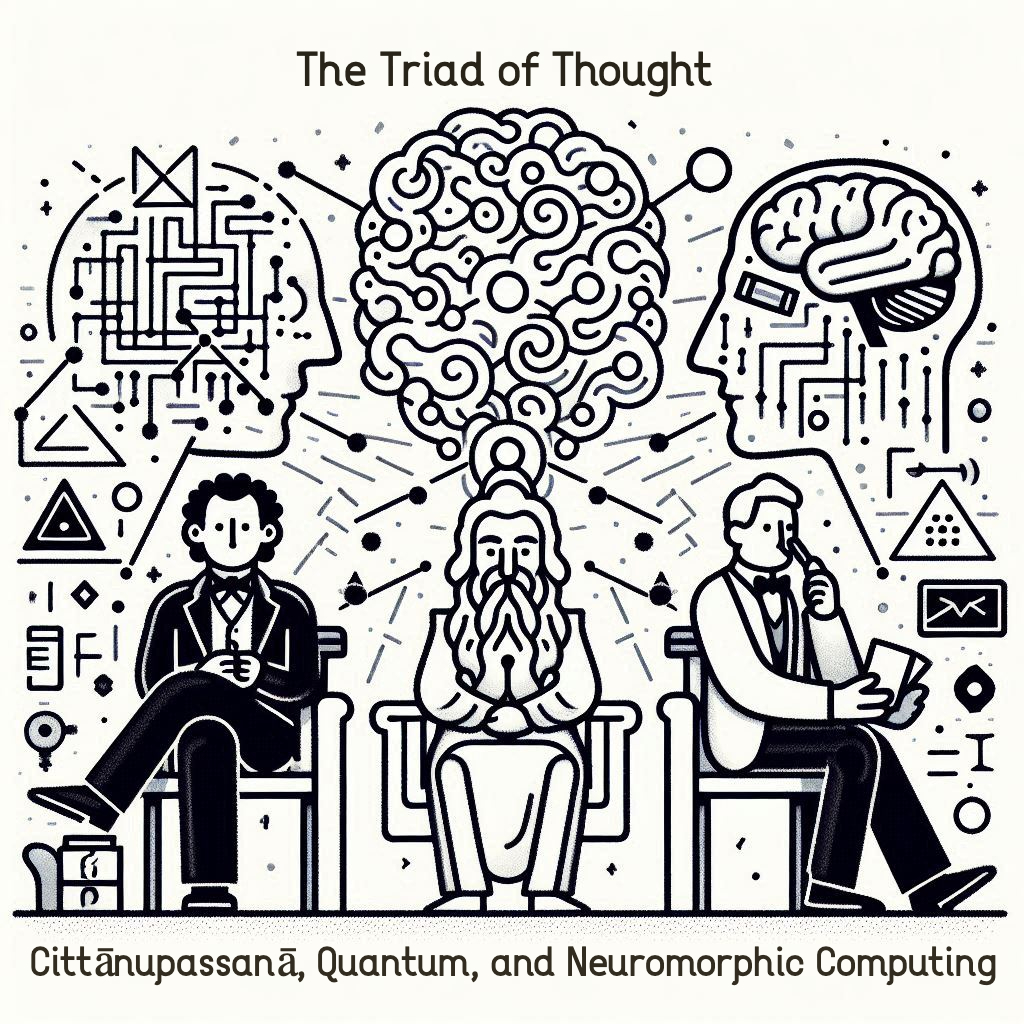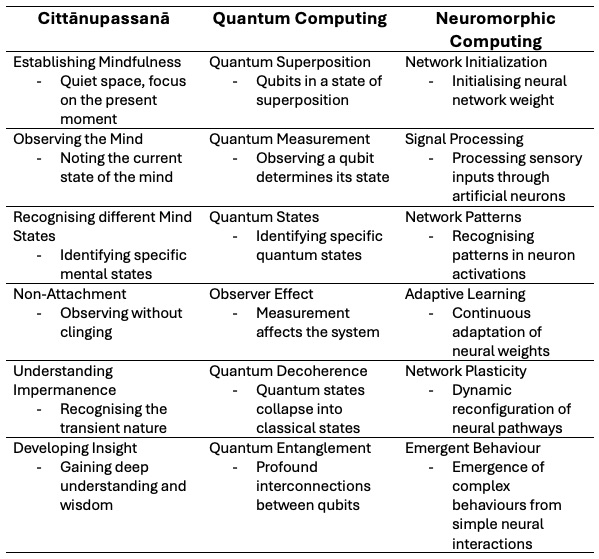Quantum computers can solve complex problems in seconds, and artificial intelligence (AI) can mimic human thought. Today, we face a paradoxical challenge: our understanding of the human mind - the creator of technological marvels, remain incomplete. This gap in our knowledge besides limiting our ability to advance technology, also raises questions about consciousness, human potential and the future of mankind. The question that begs to be answered:
Why we are still struggling to understand the most powerful processor of all: the human mind?
How can we harness the synergy between cutting-edge computing paradigms and ancient contemplative practices to unlock the mysteries of consciousness?
The Technological Frontier
Recent advancements in quantum computing, AI and neuromorphic computing have accelerated at an unprecedented pace. Google’s quantum computer achieved quantum supremacy in 20191,2, while large language models like GPT-4 demonstrate increasingly human-like text generation capabilities3,4 and neuromorphic chips like Intel's Loihi are pushing the boundaries of brain-inspired computing5,6. These technologies hold the potential to revolutionise our world, but without a deep understanding of consciousness, we risk losing sight of what it means to be truly human. Already there are many speculations of AI (Generative AI) displacing the work force yet we are still struggling to stay ahead of technology.
Are we or are we not?

Despite remarkable progress in technology, there remains a significant gap in our comprehension of consciousness which raises critical questions about the implications of these advancements. As we integrate AI and quantum computing into our daily lives, we must consider not only the efficiency and capabilities these technologies bring but also the ethical and philosophical ramifications of their use in society. Without a deeper understanding of the nature of consciousness, we risk making decisions that could have profound and unintended consequences for humanity. As quantum computing and AI rapidly advance, it is crucial to establish robust ethical frameworks to guide their development and application. Several organizations have begun creating AI and quantum computing codes of ethics, recognizing the need to formally define the role of these technologies in relation to the continued development of the human race. These frameworks should be built upon existing principles for AI ethics, while also considering the unique challenges posed by quantum mechanics.
Recent studies in cognitive science and AI highlight this gap, showing that while AI can replicate certain cognitive functions, it fails to grasp the subjective experience and self-awareness that characterize human consciousness. This discrepancy highlights a critical issue: our technological capabilities are outpacing our understanding of the mind that created them. The risk is twofold:
-
We may develop powerful AI systems without fully understanding the nature of intelligence and consciousness, potentially leading to unforeseen consequences.
-
We may fail to harness the full potential of human cognition, limiting our ability to address complex global challenges.1
Theoretical Background
Quantum Computing: A New Paradigm of Information Processing
Quantum computing represents a revolutionary approach to information processing, leveraging the principles of quantum mechanics to perform computations that are infeasible for classical computers. Three key concepts underpin this paradigm:
-
Superposition - The ability of quantum systems to exist in multiple states simultaneously. This principle allows quantum computers to process a vast amount of information simultaneously. For instance, while a classical bit can be either 0 or 1, a qubit can represent both 0 and 1 at the same time, enabling quantum computers to perform many calculations in parallel.
-
Entanglement - The phenomenon where quantum particles become interconnected and the state of one instantly influences the other regardless of the distance separating them. This property is crucial for quantum computing as it allows qubits to be correlated in ways that classical bits cannot be, leading to faster processing of complex problems.
-
Quantum Observation - The act of measurement that collapses the wave function, as described in the Copenhagen interpretation of quantum mechanics, which posits that quantum systems do not have definite properties until they are measured. The measurement process fundamentally alters the state of the system, a concept that is integral to understanding how quantum computing operates.
These principles not only enable quantum computers to solve complex problems exponentially faster than classical computers but also offer a new lens through which to view the nature of reality and consciousness itself.
Neuromorphic Computing: Emulating the Brain’s Architecture
Neuromorphic computing takes inspiration from the structure and function of the human brain. This approach aims to create hardware and software systems that mimic neural networks, offering several key advantages:
-
Energy Efficiency: Neuromorphic systems can process information with significantly lower power consumption compared to traditional von Neumann architectures.
-
Parallel Processing: Like the human brain, neuromorphic systems excel at parallel processing, making them ideal for tasks such as pattern recognition and sensory processing.
-
Adaptability: These systems can learn and adapt in real-time, much like biological neural networks.
The development of neuromorphic computing not only advances our ability to create more brain-like AI systems but also provides insights into the computational principles underlying cognition and consciousness.
The Contemplative Perspective: Insights from Buddhist Philosophy
Cittānupassanā: The Art of Mind Observation
Cittānupassanā7 is a core practice in Buddhist mindfulness which involves the systematic observation of consciousness itself. It is one of the four foundations of mindfulness (Satipaṭṭhāna) in Buddhist practice. Key aspects of Cittānupassanā8 include:
-
Non-judgmental awareness of mental states.
-
Recognition of the impermanence of thoughts and emotions.
-
Insight into the nature of consciousness as a process rather than a fixed entity.
These practices offer a first-person methodology for investigating consciousness, providing data that is often overlooked in traditional scientific approaches.
Bridging Science and Contemplative Practices
Traditional scientific approaches to studying the mind have made significant strides in understanding the neural correlates of consciousness. However, they often fall short in explaining the subjective, experiential aspects of consciousness—the “hard problem” as defined by philosopher David Chalmers 9.
Chalmers articulated that while it may be possible to explain various cognitive functions and behaviours through physical processes, the deeper question remains:
why do these processes result in the experience of consciousness itself?
In contrast, Buddhist contemplative practices, particularly Cittānupassanā, offer a complementary approach to understanding the mind. These practices provide insights into the nature of consciousness through direct, first-person experience, yet they have often been overlooked or undervalued in mainstream cognitive science research. This disconnect hampers our ability to create truly intelligent systems and fully understand the potential of human cognition.
The convergence of quantum computing, neuromorphic systems, and Buddhist contemplative practices offers a unique opportunity to reframe our understanding of consciousness and cognition. This synthesis suggests several intriguing possibilities:
1. Quantum Effects in Neural Processing
The Orchestrated Objective Reduction (Orch-OR) theory, proposed by Penrose and Hameroff, suggests that quantum processes in microtubules within neurons could be the basis for consciousness. This aligns with Buddhist notions of momentary consciousness and the quantum principle of superposition, where multiple states can coexist until observation.
2. Neuromorphic Systems as Models of Consciousness
As neuromorphic computing evolves, it provides increasingly sophisticated models of neural processing. By incorporating principles from quantum computing and insights from Buddhist practices, we may develop neuromorphic systems that more accurately reflect the complexity and nuance of human consciousness.
3. Mindfulness as a Tool for Quantum Observation
The parallels between quantum observation and mindfulness practice suggest a deeper connection between phenomenology and physical reality. Just as the act of measurement collapses the quantum wave function, the practice of mindfulness allows us to observe and potentially influence our mental states.

This image visually represents the comparison between the practice of Cittānupassanā and the modern principles of quantum computing and neuromorphic computing:
-
Preparation and Initialization:
-
Cittānupassanā: Establishing mindfulness in a quiet space, focusing on the present moment
-
Quantum Computing: Qubits in multiple states simultaneously (quantum superposition)
-
Neuromorphic Computing: Initializing artificial neural networks with brain-inspired architectures
-
-
Observation and Information Processing:
-
Cittānupassanā: Noting the current state of mind
-
Quantum Computing: Observing the state of qubits (quantum measurement)
-
Neuromorphic Computing: Processing sensory inputs through artificial neurons (spike-based computation)
-
-
Recognizing States and Patterns:
-
Cittānupassanā: Identifying specific mental states
-
Quantum Computing: Identifying specific quantum states
-
Neuromorphic Computing: Recognizing spatiotemporal patterns in neural activations
-
-
Non-Attachment and Adaptive Learning:
-
Cittānupassanā: Observing without clinging
-
Quantum Computing: Measurement affects the state of qubits (observer effect)
-
Neuromorphic Computing: Continuous adaptation of synaptic weights (plasticity)
-
-
Understanding Impermanence and Dynamic Reconfiguration:
-
Cittānupassanā: Recognizing the transient nature of phenomena
-
Quantum Computing: Collapse of superposition into a single state (quantum decoherence)
-
Neuromorphic Computing: Dynamic reconfiguration of neural pathways (neuroplasticity)
-
-
Developing Insight and Emergent Behavior:
-
Cittānupassanā: Gaining deeper understanding and wisdom
-
Quantum Computing: Deep interconnection between qubits (quantum entanglement)
-
Neuromorphic Computing: Emergence of complex cognitive behaviours from simple neural interactions.
-
These parallels highlight the potential synergies between ancient mindfulness practices, quantum phenomena, and brain-inspired computing architectures. They suggest intriguing possibilities for cross-pollination of ideas:
-
Could the non-linear, adaptive nature of neuromorphic systems provide insights into the fluid states of consciousness observed in deep meditation?
-
Might the principles of quantum superposition and entanglement inform new approaches to neuromorphic architecture design?
-
Could insights from meditators' experiences guide the development of more brain-like artificial neural networks?
Implications for Cognitive Science and Consciousness Studies
By synthesizing insights from these seemingly disparate fields, we can:
-
Advance understanting on models of cognition that account for both the quantum-like properties of mental processes and the experiential aspects of consciousness.
-
Consider the application of various philosophies on sophisticated AI systems that better replicate human-like awareness and ethical decision-making.
-
Investigate how to enhance human cognitive potential by applying insights from both quantum computing and contemplative practices.
As this field of study progresses, several ethical considerations emerge:
-
The potential for quantum computing and neuromorphic systems to model or even manipulate consciousness raises significant privacy and autonomy concerns.
-
The integration of Buddhist practices into scientific research must be done with cultural sensitivity and respect for their original context.
-
Our enhanced understanding of consciousness should inform the development of more ethical and human-centric AI systems.
The journey to understand consciousness is not just a scientific endeavor but a deeply human one. It challenges us to reconsider our place in the universe and the nature of reality itself. As we stand on the brink of creating machines that can think, it becomes ever more crucial to understand the essence of our own consciousness.
-
Conover, E. (2019). Google claimed quantum supremacy in 2019 — and sparked controversy. Science News https://www.sciencenews.org/article/google-quantum-supremacy-claim-controversy-top-science-stories-2019-yir ↩
-
Cho, A. (2019). Google claims quantum computing milestone. Science. https://www.science.org/doi/10.1126/science.365.6460.1364 ↩
-
https://platform.openai.com/docs/models/gpt-4-turbo-and-gpt-4 ↩
-
Awan, A.A. (2024). What is GPT-4 and Why Does it Matter? DataCamp. https://www.datacamp.com/blog/what-we-know-gpt4 ↩
-
Moore, S.K. (2021). Intel's Neuromorphic Chip Gets A Major Upgrade. IEEE Spectrum. https://spectrum.ieee.org/neuromorphic-computing-with-lohi2 ↩
-
Taking Neuromorphic Computing to the Next Level with Loihi 2 Technology Brief. https://www.intel.com/content/www/us/en/research/neuromorphic-computing-loihi-2-technology-brief.html ↩
-
Cittānupassanā is one of the four foundations of mindfulness, detailing how practitioners should observe the mind and its various states, such as lust, anger, and delusion. https://ancient-buddhist-texts.net/Texts-and-Translations/Satipatthana/Satipatthana-17.htm ↩
-
Acharya K. (2016). Cittānupassanā–Contemplation of the Mind. The Buddhist Path to Enlightenment. https://www.wisdomlib.org/buddhism/essay/the-buddhist-path-to-enlightenment-study/d/doc1187761.html ↩
-
What is the hard problem of consciousness? https://philosophyalevel.com/posts/what-is-the-hard-problem-of-consciousness/ ↩